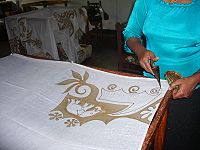Resist

A resist, used in many areas of manufacturing and art, is something that is added to parts of an object to create a pattern by protecting these parts from being affected by a subsequent stage in the process.[2] Often the resist is then removed.
For example in the resist dyeing of textiles, wax or a similar substance is added to places where the dye is not wanted. The wax will "resist" the dye, and after it is removed there will be a pattern in two colours. Batik, shibori and tie-dye are among many styles of resist dyeing.[3][4]
Wax or grease can also be used as a resist in pottery, to keep some areas free from a
Etching
The Oxford English Dictionary does not record the word "resist" in this sense before the 1830s, when it was used in relation to both "calico-printing" (1836) and metalwork with copper (1839).[14] Resists were also used to etch steel from the mid 19th-century.[15]
Gallery
-
Yūzen resist technique, with crisp, thin white outlines around the dyed patterns, created by ridges of resist paste that separate areas of dye
-
Detail of tie-dyed silk (kanako shibori) with embroidery, Japan, 17th century. Pressure resist, no paste.
-
Jizhou ware tea bowl with natural leaf resist decoration and brown glaze, late southern Song dynasty, about 1200–1279
-
A problem in a silicon integrated circuit wafer. The pink and blue irregularly-shaped rectangles are areas of photoresist that should have been fully developed and rinse away (purple), but there was a defect in processing. Seen under differential interference contrast microscopy.
References
- ^ British Museum page
- OED, "Resist", 3. "Any composition applied to a surface to protect it in part from the effects of an agent employed on it for some purpose".
- ^ Resist-dyed textiles, Victoria and Albert Museum, London
- ISBN 4770023995, 9784770023995
- ISBN 071482593X
- ^ Medley, pp. 158–159
- ^ Beard, Peter, Resist and Masking Techniques (Ceramics Handbooks), 1996, University of Pennsylvania Press,
ISBN 0812216113, 9780812216110
- ISBN 1581808046, 9781581808049, google books
- ISBN 1136084304, 9781136084300
- ISBN 366204160X, 9783662041604, google books
- ^ Jackson, R. L. "Relief Electro-Etching for Champlevé Enamelling". Guild of Enamellers. Retrieved 30 October 2016.
- ^ Nontraditional Chemical Processes
- ISBN 0471360112, 9780471360117, google books
- OED, "Resist", 2. and 3. (original edition)
- ISBN 978-1-136-10613-2.





